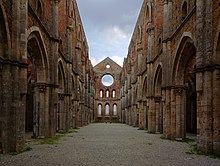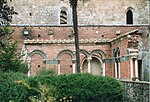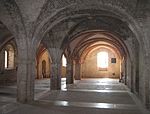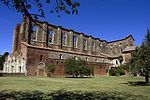
A chapter house or chapterhouse is a building or room that is part of a cathedral, monastery or collegiate church in which meetings are held. When attached to a cathedral, the cathedral chapter meets there. In monasteries, the whole community often met there daily for readings and to hear the abbot or senior monks talk. When attached to a collegiate church, the dean, prebendaries and canons of the college meet there. The rooms may also be used for other meetings of various sorts; in medieval times monarchs on tour in their territory would often take them over for their meetings and audiences. Synods, ecclesiastical courts and similar meetings often took place in chapter houses.
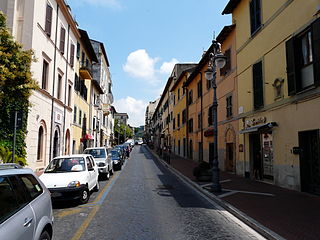
Grottaferrata is a small town and comune in the Metropolitan City of Rome, situated on the lower slopes of the Alban Hills, 20 kilometres south east of Rome. It has grown up around the Abbey of Santa Maria di Grottaferrata, founded in 1004. Nearby communes include Frascati, Rocca di Papa, Marino and Rome.

One of the first streams of Romanesque architecture in Europe from the 10th century and the beginning of 11th century is called First Romanesque or Lombard Romanesque. It took place in the region of Lombardy and spread into Catalonia and into the south of France. Its principal decoration for the exterior, bands of ornamental blind arches are called Lombard bands. It was characterized by thick walls and lack of sculpture in facades, and with interiors profusely painted with frescoes.

The Abbey of Fontenay is a former Cistercian abbey located in the commune of Marmagne, near Montbard, in the département of Côte-d'Or in France. It was founded by Saint Bernard of Clairvaux in 1118, and built in the Romanesque style. It is one of the oldest and most complete Cistercian abbeys in Europe, and became a UNESCO World Heritage Site in 1981. Of the original complex comprising church, dormitory, cloister, chapter house, caldarium, refectory, dovecote and forge, all remain intact except the refectory and are well maintained. The Abbey of Fontenay, along with other Cistercian abbeys, forms a connecting link between Romanesque and Gothic architecture.
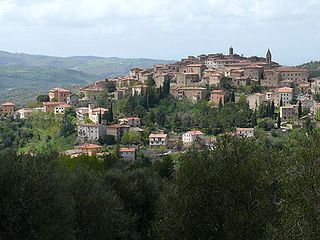
Seggiano is a comune (municipality) in the Province of Grosseto in the Italian region Tuscany, located about 100 kilometres (62 mi) south of Florence and about 40 kilometres (25 mi) northeast of Grosseto.

The Abbey of Sant'Antimo, Italian: Abbazia di Sant'Antimo, is a former Benedictine monastery located in Castelnuovo dell'Abate, in the comune of Montalcino, Tuscany, central Italy. It is approximately 10 km from Montalcino about 9 km from the Via Francigena, the pilgrim route to Rome. After many years of disuse, the abbey was reoccupied in 1992 by a small community of Premonstratensian Canons Regular. Since January 2016, the occupants are a community of monks of the Olivetan Benedictine order.
Val di Merse is one of the regions of the province of Siena, in Tuscany, on the border with the Upper Maremma. The territory comprises the area between the rivers Farma and Merse.

Galgano Guidotti was a Catholic saint from Tuscany born in Chiusdino, in the modern province of Siena, Italy. His mother's name was Dionigia, while his father's name only appeared in a document dated in the 16th century, when the last name Guidotti was attributed.
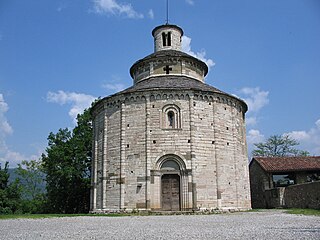
The Rotonda di San Tomè is a church in the comune (municipality) of Almenno San Bartolomeo, in the province of Bergamo, Lombardy, Northern Italy.

Gothic architecture appeared in the prosperous independent city-states of Italy in the 12th century, at the same time as it appeared in Northern Europe. In fact, unlike in other regions of Europe, it did not replace Romanesque architecture, and Italian architects were not very influenced by it. However, each city developed its own particular variations of the style. Italian architects preferred to keep the traditional construction methods established in the previous centuries; architectural solutions and technical innovations of French Gothic were seldom used. Soaring height was less important than in Northern Europe. Brick rather than stone was the most common building material, and marble was widely used for decoration. In the 15th century, when the Gothic style dominated northern Europe and Italy, the north of the Italian Peninsula became the birthplace of Renaissance architecture.

The Basilica of San Domenico, also known as Basilica Cateriniana, is a basilica church in Siena, Tuscany, Italy, one of the most important in the city.

The Abbey of Monte Oliveto Maggiore is a large Benedictine monastery in the Italian region of Tuscany, 10 km south of Asciano. Its buildings, which are mostly of red brick, are conspicuous against the grey clayey and sandy soil—the Crete senesi which give this area of Tuscany its name.

The Abbey of Santa Maria di Rovegnano is a Cistercian monastic complex in the comune of Milan, Lombardy, northern Italy. The borgo that has developed round the abbey was once an independent commune called Chiaravalle Milanese, now included in Milan and referred to as the Chiaravalle district.
The Abbey of San Giusto is a former Cistercian monastery located in the valley of the river Marta approximately 4 km south of Tuscania, Province of Viterbo, Italy.
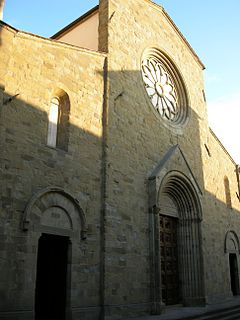
The Cathedral of Sansepolcro is a Catholic church in Sansepolcro, Tuscany, central Italy.
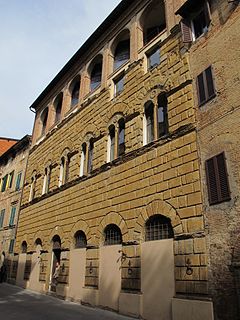
The Palazzo San Galgano is a Renaissance style urban palace located on via Roma number 47, in Terzo Camollia of the city of Siena, region of Tuscany, Italy. The palace is around the corner from the church of San Raimondo.
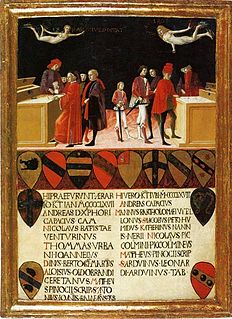
The Biccherna was the magistrate or chancellery of finance from the 13th to the 14th century for the republic and then city of Siena, region of Tuscany, Italy.

Neustadt am Main Abbey was an abbey of the Benedictine Order in Neustadt am Main, Bavaria, Germany. It existed from the 8th century until the dissolution of abbeys in the course of secularization in 1803. During its heyday in the early Middle Ages, the abbey was a political power that vied for regional influence with the Prince-bishops of Würzburg, the Archbishops of Mainz and the Counts of Rieneck. Today its location is occupied by a monastery operated by the nuns of the "Dominican Order of Saint Catherine of Siena", also known as Kloster Neustadt. The former abbey church today serves as the Catholic parish church for Neustadt.

The Basilica of Santa Maria at Pie' di Chienti was a former Roman Catholic monastery and church located in a rural site on the north bank of the Chienti river, just outside of the town of Montecosaro Scalo, in the province of Macerata, region of Marche, Italy. The church is also known as the Santissima Annunziata.
